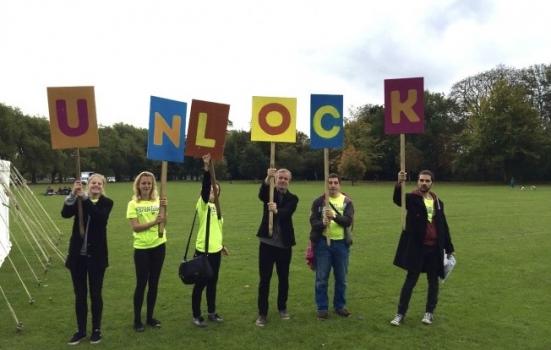Through the Circuit network, 15 to 25 year olds create arts events for other young people. Rachel Escott reveals what they’ve learned about marketing to this under-engaged audience.

Mike Cameron
Through Circuit, ten galleries across England and Wales are connecting 15 to 25 year olds to the arts and to each other. The galleries have enabled young people to draw on professional expertise to create and run their own events and activities for other young people, and to share and pass on what they learn to others in the national Circuit network.
Circuit is led by Tate and funded by the Paul Hamlyn Foundation, and aims to be peer-led by the young people. Through this, the art galleries themselves can learn and develop their practice towards youth audiences. One strand of activity is the programming and marketing of eight large-scale festivals over the four years.
Distribute leaflets and giveaways at grassroots level, ideally by young people at youth hotspots such as selected shopping areas, colleges, music events and youth centres
Starting with Hyperlink at Tate Modern in 2013, the festival baton passed to Blueprint at Tate Liverpool in 2014, then Unlock Cambridge and Affinity at Nottingham Contemporary last year.
Each festival team explored ways of getting to know its target audiences in order to understand that young people come in all shapes and sizes, and how the programming of each festival might respond to that.
Circuit’s reflective practice has generated the following insights and recommendations:
- Concentrate on the mechanics of marketing very early and be flexible. Involving young people in decisions extends the usual lead-times significantly.
- Young people’s ‘voice’ should be reflected in the marketing. Involve them in creating a design brief and in the initial meetings with designers, but then manage the design process directly until final options are presented to an agreed schedule that fits around exams and other activities.
- Dedicated marketing members in the youth group can learn, with professional staff guidance, to understand new audiences and the best ways to connect with them by mapping areas of the programme and messages that would appeal to key target groups.
- Plan strategically to engage hard-to-reach audiences, through involving the community and potential audiences in organising the festival as well as targeting publicity to them. Focus groups can help inform and provide feedback on branding and programme development.
- Realise that acts and events may be confirmed late, so have a brand or ‘save the date’ marketing plan in place earlier.
- Plan who takes responsibility for ‘seeding’ word of mouth and how. Work with artists or brands well known to the target audience, especially ones with a strong social media presence, and contract them to tweet to their followers. Sometimes a local band, brand or venue has more resonance with local young people than a higher-profile ‘youth brand’.
- Have a mass-participation social media-led campaign such as a competition for early engagement. Distribute leaflets and giveaways at grassroots level, ideally by young people at youth hotspots such as selected shopping areas, colleges, music events and youth centres.
- Employ dedicated social media coordinators from the collective to steer the marketing campaign and create content. This will ensure authenticity of the digital voice and create a link with the programming team.
- Plan, design and evaluate social media campaigns. Choose digital channels carefully. 21 to 25 year olds are more likely to be on email lists or Facebook while younger people are more likely to be on Twitter and Snapchat.
- Have a continued presence across Instagram in advance and on the day. Section up the festival day itself so that young people take turns in live posting on relevant channels.
- Create a single hashtag and use it everywhere – all campaigns and material and on-site during the festival.
- Produce a specific website and Facebook page to generate further visitors.
- Advertise details such as drop-in workshops more clearly than simply in the programme, and market them early.
- Collaborate with other venues in the city to ensure early advertising and promotion.
- Use a full variety of media to promote events – social media, flyers, posters, adverts, radio, TV, news items, presentations in schools or youth clubs, and more. People need to hear about it several times over.
Rachel Escott is Audience Development and Marketing Consultant to Circuit.
circuit.tate.org.uk
Circuit Unlocks CambridgeThe Unlock Cambridge festival was multi-site, city centre festival with pop-up events and performances, created by Circuit Cambridge, a partnership between Kettle’s Yard and Wysing Arts Centre. The marketing challenges included an under-engaged target audience, locations and a programme that was confirmed very late in the day and, with Kettle’s Yard closed, we were missing a city centre venue to promote the event. These also created opportunities as the festival was in central locations in the city with many passers-by. We created a new brand, away from the constraints of the galleries’ identities, and we used the unconfirmed (or ‘secret’) venues to our advantage. Before the festival, we gained valuable insights by working closely with the peer-led group on marketing other Circuit events. We found that text-heavy print in gallery branding was not effective. We wanted a strong festival brand that was bold, eye-catching and distinct from either of our galleries. Inspired by other youth-orientated brands and the three separate programme elements (play, do, see), the new brand comprised striking and distinctive shapes, textures and fonts. It was also used on eye-catching signage at the festival including floor stickers and large shape signs, which helped to draw in visitors on the day. Instagram was the best social network for the target age group, with the highest rate of engagement. We posted under the theme of unlocking Cambridge, which generated content and emphasised the theme of the festival. Susie Biller is Press and Marketing Officer and Freya Jewitt is Communications & Events Assistant, both at Kettle’s Yard. |




